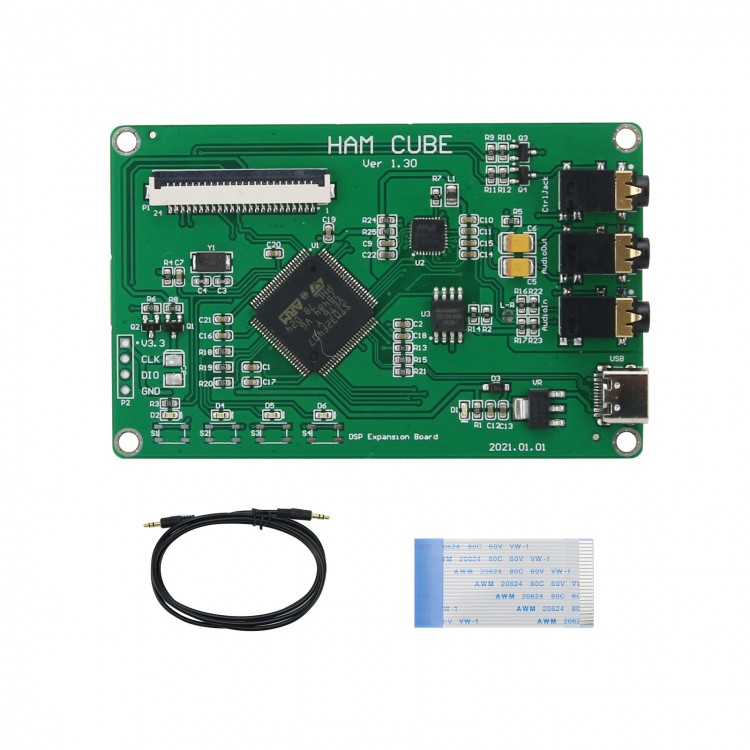
| Quantity | 3+ units | 10+ units | 30+ units | 50+ units | More |
|---|---|---|---|---|---|
| Price /Unit | $40.78 | $39.95 | $38.70 | $37.03 | Contact US |
 For Toshiba TA8184 Audio Tone Control Board HiFi Preamp Tone Board Support Electronic Volume Control
$27.84
For Toshiba TA8184 Audio Tone Control Board HiFi Preamp Tone Board Support Electronic Volume Control
$27.84
 HiFi 5-Segment Ultra-low Noise Audio Tuning Board Preamplifier BA3822 Equalizer +/-11dB Adjustment
$35.22
HiFi 5-Segment Ultra-low Noise Audio Tuning Board Preamplifier BA3822 Equalizer +/-11dB Adjustment
$35.22
 2.1 Audio System Bluetooth Digital Power Amplifier Board TPA3116 2x50W + 100W Subwoofer 8-26VDC Input
$25.20
2.1 Audio System Bluetooth Digital Power Amplifier Board TPA3116 2x50W + 100W Subwoofer 8-26VDC Input
$25.20
DSP CW Audio Decoder Board DAC Expansion Board Upgraded Version For Shortwave Morse Telegraph Code
Description:
The newly designed DSP CW audio decoder board (upgraded version) is used to identify CW audio signals. Suitable for CW audio signal recognition of shortwave radios and walkie-talkies. Compared with the basic version of decoder board, the upgraded version adds several filter options and a variety of digital noise reducer settings, which can effectively improve the sound quality of received signal, reduce shortwave noise, and improve decoding accuracy to a certain extent. In recent years, short-wave band electromagnetic interference has become increasingly serious, and short-wave signals have the characteristics of great fading and poor signal-to-noise ratio. Therefore, effectively separating CW signals from short-wave backgrounds has always been a recognized problem, so it is limited by hardware itself and software algorithm, the decoding accuracy of CW signals is difficult to reach 100%. The decoding accuracy is directly proportional to the quality of the signal and the signal-to-noise ratio. The better the signal, the higher the signal-to-noise ratio, and the higher the decoding accuracy.
Given that the current CW machine decoding is still difficult to replace manual dictation, machine CW decoding can only be used as an auxiliary means of CW dictation receiving at present, and cannot totally rely on machine decoding. This is unrealistic.
The USB interface of the decoder board is a Type-C interface, which is used for external power supply or system firmware upgrade. The interface starting from the USB port is defined as: CW audio input (connected to the audio output of radio), CW audio output (can be connected to headphones or speakers, must be a stereo jack, inserting a mono plug will cause output short-circuit protection and cause no sound) and a CW and PTT output interface (the left and right channels of the stereo jack control the external output of CW and PTT respectively. Note that this is a non-isolated control port). There are two LEDs on the board, which are power indication and signal detection indication. However, these two LEDs are invisible after they are actually installed in a case. The signal detection indication can be transmitted to your main controller panel through the interface and displayed synchronously to check the size of signal input and decoding status.
The high CW decoding accuracy rate depends on the quality of the signal on the one hand, and on the other hand it has a lot to do with the size of the signal input. It is necessary to ensure that the audio size of the input decoder board is within an appropriate range. When the input signal is too large, it is easy to cause the signal to be overloaded, and thus cannot be decoded. If the input signal is too small, the detection threshold of the decoding cannot be triggered and the decoding cannot be caused. The performance of the two situations can be observed through the signal detection indicator LED. If the LED light is always on when there is no signal, it is a signal overload. If the signal detection LED cannot flash when there is a signal, the signal amplitude is too low.
Generally, the audio amplitude of the input decoder is controlled by changing radio volume or RF gain. The adjustment method is: when there is no signal, slowly reduce the radio volume or RF gain so that the signal detection indicator just goes out (occasionally flashing for three to five seconds is fine). At this time, the decoding detection threshold is the most sensitive state, and the decoding success rate is relatively highest.
The decoder board can be used with HamCube main controller and is compatible with all versions of HamCube main controller V1.07-V1.30.
Watch Operation Videos Here:
Introduction to main controller and basic operation video:
https://www.bilibili.com/video/BV1mZ4y1W7dR/
Menu setting video 1:
https://www.bilibili.com/video/BV1Lp4y197tc/
Menu setting video 2:
https://www.bilibili.com/video/BV18K41157zx/
Menu setting video 3:
https://www.bilibili.com/video/BV1ja4y147oc/
HamCube main controller and decoder board assembly video:
https://www.bilibili.com/video/BV1Up4y1X7ZQ/
Video for HamCube decoder board using and adjustment:
https://www.bilibili.com/video/BV1Dg4y1z7j8/
Package Included:
- 1 x Set of Decoder Board
Note:
- Since this product is a small batch DIY product, there are still some areas that need continuous improvement. If users have high requirements for the performance and quality of the machine, please think twice before purchasing.
- About the latest firmware and user manual of the decoder board, please contact us. Thank you!